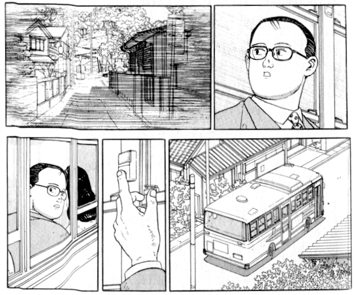Jiro Taniguchi
Jiro Taniguchi (谷口 ジロー, Taniguchi Jirō, 14 August 1947 – 11 February 2017) was a Japanese manga writer/artist. His works belong to the gekiga, or "dramatic pictures", genre of manga.[1] In France he was knighted a Chevalier of the Ordre des Arts et des Lettres in 2011.[2]
Jiro Taniguchi | |
|---|---|
 Jiro Taniguchi at Lucca Comics and Games in 2011 | |
| Born | August 14, 1947 Tottori, Tottori Prefecture, Japan |
| Died | February 11, 2017 (aged 69) Tokyo, Japan |
| Occupation | Manga artist |
| Nationality | Japanese |
| Notable works | Bocchan No Jidai Icaro Haruka na Machi e Chichi no Koyomi |
| Notable awards | Tezuka Osamu Cultural Prize (1998) |
| Signature | |
Career


Taniguchi began his career as an assistant of manga artist Kyuuta Ishikawa. He made his manga debut in 1970 with Kareta Heya (A Desiccated Summer), published in the magazine Young Comic.
From 1978 to 1986, he created several hard-boiled comics with the scenarist Natsuo Sekigawa, such as City Without Defense, The Wind of the West is White and Lindo 3. From 1987 to 1996, Taniguchi and Natsuo Sekigawa produced the 5-volume series Botchan no Jidai. In the 1990s, he came up with several albums, among which Aruku Hito (歩くひと), Chichi no Koyomi (父の暦), and Hitobito Shirīzu: Keyaki no Ki (人びとシリーズ「けやきのき」).
From 1980 to 1983, he collaborated with Garon Tsuchiya for the manga Blue Fighter (青の戦士, Ao no Senshi), Knuckle Wars (ナックル・ウォーズ, Nakkuru Wōzu) and Live! Odyssey (LIVE! オデッセイ).
He illustrated Baku Yumemakura’s works, Garouden from 1989 to 1990 and Kamigami no itadaki (The Summit of the Gods) from 2000 to 2003. The later received awards at the Angoulême International Comics Festival in 2002 and 2005. For Kamigami no itadaki, he hiked to Kathmandu, Nepal for research.[1]
In 1997, he created the Ikaru (Icarus) series with texts by Mœbius.[1]
Jiro Taniguchi gained several prizes for his work. Among others, the Osamu Tezuka Culture Award (1998) for the series Botchan no Jidai, the Shogakukan prize with Inu o Kau, and in 2003, the Alph'Art of the best scenario at the Angoulême International Comics Festival (France) for A Distant Neighborhood. His work has been translated in many languages. Mexican filmmaker Guillermo del Toro praised his work, stating that "Taniguchi was a manga poet. The Kieslowski of the page. A serene, profound observer of the world."[3]
A Distant Neighborhood was adapted into a live-action Belgian film in 2010.[4]
Taniguchi has cited Hiroshi Hirata, Takao Saito, Moribi Murano, and Kyuuta Ishikawa as major influences.[1]
Taniguchi died on 11 February 2017 in Tokyo, at the age of 69.[4]
Bibliography
1980s and earlier
- 1979 – Lindo 3!
- 1980 – Muboubi Toshi
- 1980 – Ooinaru Yasei
- 1981/03 – Jiken Ya Kagyou – Trouble is my Business
- 1982/03 – Blue Fighter (Ao no Senshi)
- 1982/03 – Hunting Dog
- 1983/08 – Knuckle Wars – The Fist of Rebellion (Nakkuru Wōzu – Ken no Ran)
- 1983/03 – Shin Jiken Ya Kagyou – New Trouble is my Business
- 1983/09 – Live! Odyssey
- 1984/02 – Seifuu Ha Shiroi
- 1984/12 – Rude Boy
- 1985/10 – Enemigo
- 1986/01 – Hotel Harbour View
- 1986/10 – Blanca
- 1987/06 – Botchan no Jidai (坊っちゃんの時代), based on Botchan, a 1906 novel by Natsume Sōseki
- 1988/05 – K
- 1988/06 – Ice Age Chronicle of the Earth
1990s
- 1990/01 – Genju Jiten
- 1990/09 – Garouden (Hungry Wolves Legend)
- 1991/06 – Samurai Non Grata
- 1992/04 – Aruku Hito –(歩くひと, translated in French as L'Homme qui Marche and English as The Walking Man)
- 1992/09 – Kaze No Sho (translated in English as Samurai Legend)
- 1992/10 – Inu wo Kau
- 1993/09 – Keyaki no Ki (translated in French as L'orme du Caucase)
- 1994/09 – Mori He – Into the Forest
- 1994/11 – Chichi no Koyomi
- 1995/04 – My Father's Journal (translated in French as Le Journal de Mon Père)
- 1996/04 – Benkei in New York (N.Y.の弁慶)
- 1996/07 – Blanca II (Dog of God)
- 1997/10 – Kodoku no Gourmet
- 1998/09 – Haruka na Machi e (translated in English as A Distant Neighborhood – translated in French as Quartier Lointain)
- 1999/01 – Tokyo Genshi Gyou
- 1999/12 – Sousaku Sha – Quest for the Missing Girl
2000s
- 2000/11/30 – Ikaru
- 2000/12 – Kamigami no Itadaki (The Summit of the Gods)
- 2002/09 – Ten no Taka – Sky Hawk
- 2004/11 – Toudo no Tabibito – The Ice Wanderer
- 2005/03 – Seton
- 2005/12 – Hare Yuku Sora (晴れゆく空) – A Bright Blue Sky (translated in French as Un ciel radieux)
- 2006/03 – Sampo Mono
- 2007/09 – Mahou no Yama (The Magic Mountain)
- 2008/03 – Fuyu no Doubutsuen (A Zoo in Winter)
2010s
- 2013 – Tomoji (とも路)
- 2013 – My Year
- 2014 – Guardians of the Louvre
- 2014 – Venice (Louis Vuitton Malletier)
References
- Lehmann, Timothy (2005-11-01). Manga: Masters of the Art. Harper Collins. ISBN 978-0-06-083331-2.
- "L'auteur japonais de bande dessinée Jiro Taniguchi est mort". Huffington Post France (in French). Archived from the original on 2 March 2017. Retrieved 1 March 2017.
- Guillermo del Toro [@RealGDT] (14 February 2017). "Jiro Taniguchi was a manga poet. The Kieslowski of the page. A serene, profound observer of the world" (Tweet). Retrieved 20 February 2017 – via Twitter.
- Kelly, Seth (11 February 2017). "Japanese Manga Legend Jiro Taniguchi Dies at 69". Variety. Retrieved 12 February 2017.
External links
| Wikimedia Commons has media related to Jirō Taniguchi. |
- Jiro Taniguchi at Anime News Network's encyclopedia
- (in Japanese) Jiro Taniguchi's Town (his approved fan-site)